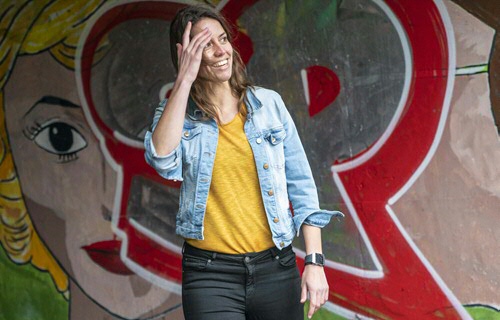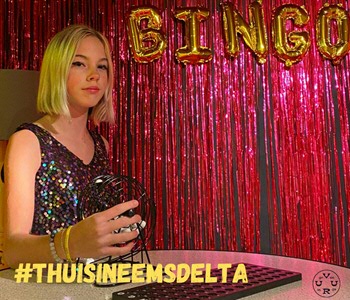Cultuur als energie voor de toekomst
De provincie Groningen gaat nog steeds aan kop als het gaat om de grootste krimp in Nederland. Het noordelijke platteland loopt al jaren leeg. Dit heeft grote gevolgen voor de leefbaarheid in dorpen. Hoe kun je er voor zorgen dat de veerkracht van de dorpen blijft behouden en zelfs wordt versterkt? Met deze vraag houdt Gwenda van der Vaart, assistent professor bij de Faculteit Ruimtelijke Wetenschappen, zich bezig.
Tekst: Merel Weijer, afd. Communicatie RUG
Een Groninger in Pingjum
Van der Vaart is een echte Groningse, geboren in het UMCG en opgegroeid in Grootegast in het Westerkwartier. Ze voelt zich verbonden met het Groninger platteland. Na de middelbare school studeerde en promoveerde ze aan de RUG. Haar proefschrift ging over een participatief onderzoeksproject, uitgevoerd in Pingjum, een dorp in Friesland. Een plek die bekend staat als kunstenaarsdorp. In vergelijking met andere dorpen in (Noord)Nederland kent het een relatief grote aanwezigheid van kunstenaars en creatievelingen en vinden er veel culturele activiteiten plaats. Van der Vaart onderzocht wat dit kan betekenen voor de veerkracht van een dorp.

Community art
Eén van haar conclusies is dat kunst het zogenaamde ‘sociaal kapitaal’ kan vergroten. Het kan een middel zijn om de verbinding tussen mensen onderling te vergroten. Het brengt mensen samen en laat ze nadenken over hun omgeving. Dit alles zorgt voor een grotere veerkracht van een gebied of een dorp. Vooral community art projecten zijn hiervoor geschikt. Daarbij werken kunstenaars samen met de inwoners van een stad of dorp. Een voorbeeld van zo’n project is Grutte Pier van PeerGrouP (locatietheatergezelschap) in Kimswerd. PeerGrouP werkte meerdere jaren samen met de inwoners aan een theatertrilogie rondom de Friese vrijheidsstrijder Grutte Pier. Van der Vaart: “Lange tijd was het dorp in de ban van dit project en na afloop was men heel positief over wat het met het dorp gedaan had. Het bracht meer saamhorigheid, omdat iedereen op grote schaal samenwerkte aan één ding, en dankzij de succeservaring bouwde men ook een vertrouwen in eigen kunnen op.”

Gronings Vuur
Op dit moment is Van der Vaart betrokken bij een soortgelijk, grootscheeps project in de provincie Groningen: Gronings Vuur. Ook in Gronings Vuur werken kunstprofessionals samen met amateurs en dorpsbewoners. Het project is opgezet in opdracht van de provincie Groningen om de culturele infrastructuur te versterken. Tot nu toe is er altijd veel aandacht gegaan naar de stad en te weinig naar het Ommeland. Daar moet verandering in komen. Het project reist in anderhalf jaar langs de verschillende gemeentes met een cultureel programma. Met muziek, fotografie, film, gedichten, gesprekken en kunst laat Gronings Vuur zien wat zich afspeelt in de provincie. Elke gemeente sluit het project af met een eindpresentatie, bijvoorbeeld een theaterstuk of een expositie. De gemeente Oldambt organiseerde zelfs een (fictieve) bruiloft. In februari is de eindevaluatie: ‘Open Space’. Daar zal Van der Vaart ook haar bevindingen presenteren.
Reflectie op de toekomst
Van der Vaart werkt met vragenlijsten voor culturele spelers die lokaal het project trekken, bezoekers van de eindpresentaties, én voor het lokale culturele veld dat zelf niet deelneemt. Daarnaast interviewt ze cultuurambtenaren van de gemeentes en culturele spelers die bij het gehele project betrokken zijn, zoals VRIJDAG en De Rijdende Popschool. Uiteindelijk resulteert dit in een beschouwing op de twee doelstellingen van het project; het versterken van de culturele infrastructuur en het bespreekbaar maken van thema’s die in de specifieke gemeente spelen. Daarnaast reflecteert ze op de wensen op kunst en cultuurgebied voor de toekomst die naar voren komen uit het project.
Samen ergens naar toe werken
Ze ziet nu al dat het project een duidelijke positieve invloed heeft. “Betrokkenen geven aan dat er veel waarde wordt gehaald uit het proces van samen ergens naar toe werken. Bestaande verbindingen worden versterkt of nieuwe, soms hele verrassende worden gelegd.” Mensen geven ook aan aan het prettig te vinden dat er aandacht is voor thema’s die spelen. Onderwerpen die naar voren komen zijn ‘Hoe voel ik me thuis?’ en ‘Omgaan met anderen’ (bijvoorbeeld nieuwkomers). Uit haar promotieonderzoek weet Van der Vaart dat als het gevoel van verbinding groter is mensen sneller geneigd zijn zich in te zetten voor hun dorp of gemeenschap. Het Gronings Vuur project helpt ook bij het nadenken over wat er moet veranderen in de toekomst en hoe.

Thuis in Eemsdelta
Het project is nu aanbeland in wat per 1 januari de nieuwe gemeente Eemsdelta gaat worden. Het onderzoek heet daar #thuisineemsdelta. Bewoners kunnen objecten doneren die symbool staan voor je thuis voelen. Dit kan van alles zijn: een meubelstuk, een liedje, een recept, een foto, verhaal of een uitzicht. Cultuurmakers maken er dan een 3=1 kunstwerk van. De kunstwerken worden geëxposeerd en waren te winnen bij de recente online Eemsdelta-bingo.
Nieuwe en positieve energie
Dat het project na februari geen stille dood zal sterven is inmiddels duidelijk. De provincie heeft in het uitvoeringsprogramma voor 2021-2024 ‘Wij zijn cultuur’ aangegeven in te blijven zetten op het brengen van organisatiekracht naar de regio. Dit geeft ruimte en hoop voor veranderingen. Niet alleen voor het vergroten van de culturele infrastructuur, want daar is het Ommeland zeker bij gebaat, maar ook het versterken ervan. Zo kan de veerkracht van een gemeenschap versterkt worden en dit kan nieuwe en positieve energie geven voor de toekomst. Iets wat de krimpende noordelijke provincie zeker kan gebruiken.
Meer informatie
Meer nieuws
-
01 december 2025
De kracht van beweging
-
24 november 2025
RUG en Ministerie van I&W starten brede meerjarige samenwerking
